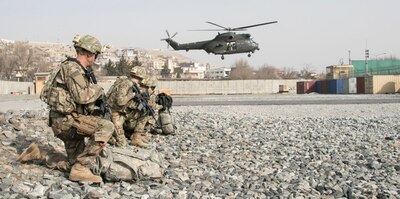By Terri Moon Cronk DoD News, Defense Media Activity
WASHINGTON, Feb. 7, 2018 — During the past weekend, U.S.
forces conducted air operations to strike Taliban and the East Turkestan
Islamic Movement, or ETIM, training facilities in Afghanistan’s Badakhshan
province, the commander of NATO air operations in Afghanistan said today.
Speaking with Pentagon reporters via satellite, Air Force
Maj. Gen. James B. Hecker, commander of NATO Air Command Afghanistan, updated
Pentagon reporters via satellite from Afghanistan on the alliance’s Resolute
Support mission there.
“The destruction of these training facilities prevents
terrorists from planning any acts near the border with China and Tajikistan,”
the general said. “The strikes also destroyed stolen Afghan National Army
vehicles in the process of being converted to vehicle-borne improvised
explosive devices.”
ETIM is a terrorist organization that operates in China and
the border regions of Afghanistan, Hecker noted. “ETIM enjoys support from the
Taliban in the mountains of Badakhshan, so hitting these Taliban training
facilities and squeezing the Taliban's support networks degrades ETIM
capabilities,” he said.
From videos of the airstrikes he showed, Hecker said, it can
be seen how a single B-52 bomber demonstrates its reach and lethality by
setting a record employment of 24 precision-guided munitions against Taliban
narcotics and training facilities.
“What allowed this impressive air power to be unleashed was
a critical modification that we made to the B-52 in late November, installing a
conventional rotary launcher that allows B-52s to carry more precision-guided
munitions,” he said.
Centcom’s Main Effort
“Afghanistan has become [U.S. Central Command’s] main
effort, thanks to the recent successes in Iraq and Syria, Hecker said. “This
has allowed Centcom to shift more assets our way, which will significantly
improve our ability to assist the Afghans.”
The general provided three examples of air assets now
available to the mission in Afghanistan. “We have increased our close air
support capabilities significantly by adding an A-10 squadron in Kandahar Air
Force Base. We now have 50 percent more MQ-9 intelligence, surveillance and
reconnaissance aircraft. And we're adding an additional combat search and
rescue squadron,” he said.
Hecker added that those are just the tangible air platforms
in Afghanistan, and the platforms would have limited value if those were the
only changes there. But another change is one you don't physically see, he told
reporters.
Intelligence Community
“It is the change of the weight of effort of the
intelligence community,” he said. “The intelligence community is the backbone
that develops our targets, provides data analysis, and eventually produces the
targets we strike in Afghanistan.”
Generation
This is the intelligence community that's spread throughout
the security enterprise beyond Afghanistan, Heckler noted. “They analyze
surveillance and reconnaissance data to develop the networks that produce
targets for our air power to strike. This behind-the-scenes legwork allows us
to hit the Taliban where it hurts most, whether it's command-and-control or
their pocketbooks.”
Cripple the Taliban’s revenue-generation enterprise is part
of that effort, he said. “We will take away their ability to wage war on the
battlefield and brutally murder innocent civilians, like the recent cowardly
acts that we witnessed in Kabul and Jalalabad,” the general said.
“With the current uplift in resources, we can decimate
Taliban command-and-control nodes,” said he added. “That means we can strike at
the heart of training camps where they brainwash young men to strap on a
suicide vest, to kill themselves and their fellow Afghans, who are working to
rebuild the country.”







No comments:
Post a Comment